The M-Education Market is estimated to be valued at USD 5.2 billion in 2025 and is projected to reach USD 22.0 billion by 2035, registering a compound annual growth rate (CAGR) of 15.5% over the forecast period.
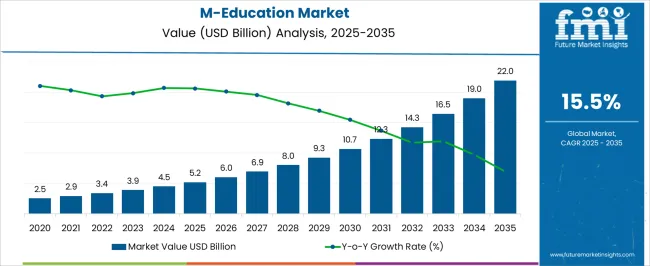
| Metric | Value |
|---|---|
| M-Education Market Estimated Value in (2025 E) | USD 5.2 billion |
| M-Education Market Forecast Value in (2035 F) | USD 22.0 billion |
| Forecast CAGR (2025 to 2035) | 15.5% |
The M-Education market is witnessing accelerated growth as mobile-based learning solutions become integral to modern education systems. Expanding smartphone penetration, enhanced internet connectivity, and the widespread availability of digital platforms are transforming how educational content is delivered and consumed. The market is benefiting from the growing preference for personalized and on-demand learning experiences, which are increasingly being supported by AI-driven content recommendations and interactive applications.
Government initiatives to promote digital literacy and investments by private institutions in mobile-enabled platforms are further shaping the sector’s growth. Corporate organizations are also embracing mobile learning as a flexible and cost-effective solution for workforce upskilling, creating demand beyond traditional education.
The ability of M-Education solutions to provide real-time assessments, adaptive learning paths, and collaborative features is reinforcing their adoption As education systems and enterprises continue to prioritize digital transformation, the M-Education market is expected to expand rapidly, offering scalable solutions that align with evolving needs for accessibility, efficiency, and learner engagement worldwide.
The m-education market is segmented by solution, learning, education level, and geographic regions. By solution, m-education market is divided into Interactive and Non-interactive. In terms of learning, m-education market is classified into Corporate learning, Distant learning, and Classroom learning. Based on education level, m-education market is segmented into Primary, Pre-primary, Secondary, Higher Secondary, and Others. Regionally, the m-education industry is classified into North America, Latin America, Western Europe, Eastern Europe, Balkan & Baltic Countries, Russia & Belarus, Central Asia, East Asia, South Asia & Pacific, and the Middle East & Africa.
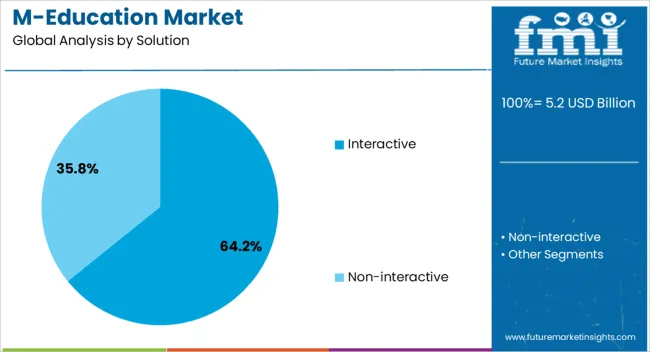
The interactive solution segment is expected to account for 64.2% of the M-Education market revenue share in 2025, making it the leading solution category. This dominance is being driven by the rising demand for engaging and immersive learning experiences that go beyond static content delivery. Interactive solutions integrate multimedia features, simulations, gamified modules, and collaborative tools, which enhance learner engagement and improve knowledge retention.
Institutions and organizations are increasingly adopting such platforms to align with the digital-first learning preferences of younger generations and tech-savvy professionals. The ability of interactive solutions to provide real-time feedback and personalized learning pathways is contributing to their widespread adoption.
Additionally, these solutions are proving effective in bridging the gap between theoretical concepts and practical application, making them particularly valuable in professional and vocational training environments With continued advancements in mobile application design and content delivery technologies, interactive solutions are expected to remain the preferred choice in the M-Education market, reinforcing their dominant market share.
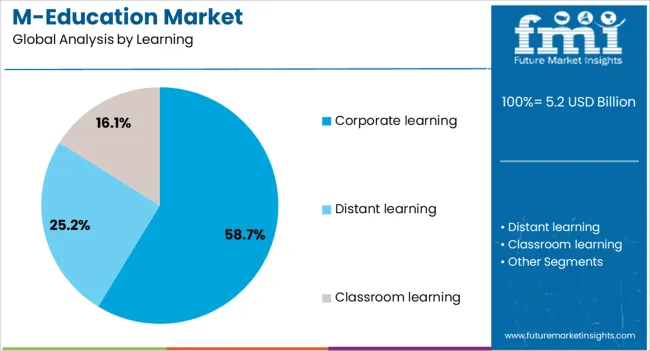
The corporate learning education level segment is projected to hold 58.7% of the M-Education market revenue share in 2025, positioning it as the leading education level category. Its leadership is being driven by the growing emphasis on workforce reskilling and upskilling in response to rapid technological advancements and evolving business needs.
Organizations are increasingly adopting mobile-based education platforms as they provide flexibility for employees to learn anytime and anywhere, without disrupting work schedules. The scalability and cost-effectiveness of M-Education platforms allow companies to deliver standardized training across global operations while ensuring content customization to meet local requirements.
The ability to integrate learning management systems with performance monitoring tools is further enhancing corporate adoption, as businesses seek measurable outcomes from training initiatives With rising demand for agile learning solutions to address skills gaps in areas such as digital literacy, data analytics, and compliance, corporate learning through mobile education platforms is expected to maintain its strong growth trajectory and dominant market share.
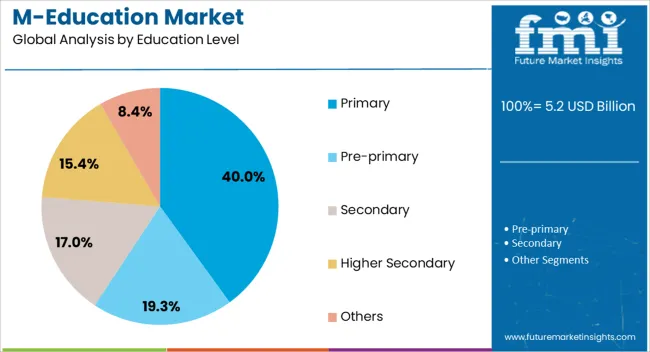
The primary education segment is estimated to capture 40.0% of the M-Education market revenue share in 2025, securing a leading position within the education level categories. This dominance is being reinforced by the growing adoption of mobile platforms to deliver foundational learning to children in early grades. Educational institutions and governments are increasingly investing in mobile-based programs to enhance accessibility, particularly in underserved regions where traditional infrastructure is limited.
Interactive and adaptive learning applications tailored for primary students are helping improve comprehension, literacy, and numeracy skills at an early age. The use of gamified features, audio-visual aids, and interactive exercises is fostering active participation and reducing learning gaps.
Parents and teachers are also embracing M-Education tools as supplementary resources to classroom instruction, reinforcing its widespread adoption With the global emphasis on improving early childhood education and ensuring equal access to learning opportunities, the primary education segment is expected to continue driving significant growth, highlighting its essential role in the long-term expansion of the M-Education market.
Smartphones have become necessity that are available at competitive price. The factor of being portable and ease of using it anywhere, at any time is making it more attractive, all that is required is an internet connection and the user is connected to anyone anywhere.
M-Education also known as m-learning is a new way to access learning content using mobile. It is form of distance education that allows learner to use educational technology on the mobile devices. Devices used for m-education includes smartphones, laptops, tablets, digital notebooks.
M-education helps the user to share and transfer learning content with other users and also used as instant feedback system. M-education helps learners to explore more and learners can access information any time. M-education is knowledge sharing source that keeps the learners constantly updated with information.
The COVID-19 pandemic is spreading worldwide which is affecting various sectors. By the end of March 2025, the pandemic had spread over 185 countries and resulted in lockdown situation everywhere.
Due to lockdown in the countries 90% schools, colleges and universities were closed which impacted over 1.4 billion students. The impact of COVID-19 pandemic has raised the need to adopt innovative ways of getting education service at all level.
Various schools and colleges are shifting towards digital technology for providing education to their students. Schools and universities have developed the intranet system that empowered a move towards digital technologies like web-conferencing tools to offer learning at home.
Mobile learning apps are gaining traction in the pandemic as these apps are leveraging opportunity and attracting new customers by providing free access to their content platform. These apps are helping in engaging the students with their teachers via live streaming and online tutorial.
Due to increasing online learning the m-education market is expected to grow at significant rate in the coming years.
Adoption of Augmented Reality for Performance Support in Organization is Spurring the Market Growth
Performance support is being provided to employees in the form of infographics, bit-sized videos, and checklist. These formats are effective in catering to the needs of employees.
As the employees are more attracted towards the technology for engaging learning content, the adoption of augmented reality for performance support is increasing.
With Augmented reality offering performance support employees can access information just by holding their smartphones in front of the particular object or product. Employees just hold the phone towards the product and all the needed information is shown on the screen. This in-turn is driving the market for m-education market.
Distraction while learning is restricting the growth of m-education market
Mobile device can be distraction for the learners especially for the younger age group, who are attracted towards playing games on mobile device rather than learning online.
For adult age group mobile learning can also be distracted if the user is constantly receiving notification and messages. Hence, due to the distraction of the user the growth of m-education market is restricted.
Poor internet connectivity on mobile devices is another such factor which could hamper the growth of m-education market

| Country | CAGR |
|---|---|
| China | 20.9% |
| India | 19.4% |
| Germany | 17.8% |
| France | 16.3% |
| U.K. | 14.7% |
| U.S. | 13.2% |
| Brazil | 11.6% |
The M-Education Market is expected to register a CAGR of 15.5% during the forecast period, exhibiting varied country level momentum. China leads with the highest CAGR of 20.9%, followed by India at 19.4%. Developed markets such as Germany, France, and the U.K. continue to expand steadily, while the U.S. is likely to grow at consistent rates. Brazil posts the lowest CAGR at 11.6%, yet still underscores a broadly positive trajectory for the global M-Education Market. In 2024, Germany held a dominant revenue in the Western Europe market and is expected to grow with a CAGR of 17.8%. The U.S. M-Education Market is estimated to be valued at USD 1.9 billion in 2025 and is anticipated to reach a valuation of USD 6.7 billion by 2035. Sales are projected to rise at a CAGR of 13.2% over the forecast period between 2025 and 2035. While Japan and South Korea markets are estimated to be valued at USD 237.4 million and USD 180.6 million respectively in 2025.
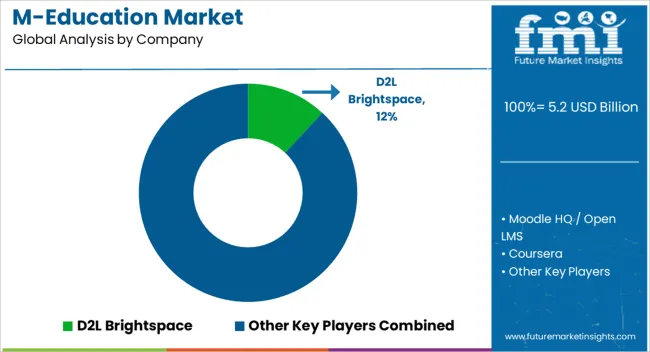
| Item | Value |
|---|---|
| Quantitative Units | USD 5.2 Billion |
| Solution | Interactive and Non-interactive |
| Learning | Corporate learning, Distant learning, and Classroom learning |
| Education Level | Primary, Pre-primary, Secondary, Higher Secondary, and Others |
| Regions Covered | North America, Europe, Asia-Pacific, Latin America, Middle East & Africa |
| Country Covered | United States, Canada, Germany, France, United Kingdom, China, Japan, India, Brazil, South Africa |
| Key Companies Profiled | D2L Brightspace, Moodle HQ / Open LMS, Coursera, 2U / edX, Pearson (Revel), Udemy Business, FutureLearn, Keypath Education, Academic Partnerships, Apple Education, Google Classroom, Huawei iLearningX, Top Hat, Kahoot! Campus, Panopto, and Echo360 |
The global m-education market is estimated to be valued at USD 5.2 billion in 2025.
The market size for the m-education market is projected to reach USD 22.0 billion by 2035.
The m-education market is expected to grow at a 15.5% CAGR between 2025 and 2035.
The key product types in m-education market are interactive and non-interactive.
In terms of learning, corporate learning segment to command 58.7% share in the m-education market in 2025.






Our Research Products

The "Full Research Suite" delivers actionable market intel, deep dives on markets or technologies, so clients act faster, cut risk, and unlock growth.

The Leaderboard benchmarks and ranks top vendors, classifying them as Established Leaders, Leading Challengers, or Disruptors & Challengers.

Locates where complements amplify value and substitutes erode it, forecasting net impact by horizon

We deliver granular, decision-grade intel: market sizing, 5-year forecasts, pricing, adoption, usage, revenue, and operational KPIs—plus competitor tracking, regulation, and value chains—across 60 countries broadly.

Spot the shifts before they hit your P&L. We track inflection points, adoption curves, pricing moves, and ecosystem plays to show where demand is heading, why it is changing, and what to do next across high-growth markets and disruptive tech

Real-time reads of user behavior. We track shifting priorities, perceptions of today’s and next-gen services, and provider experience, then pace how fast tech moves from trial to adoption, blending buyer, consumer, and channel inputs with social signals (#WhySwitch, #UX).

Partner with our analyst team to build a custom report designed around your business priorities. From analysing market trends to assessing competitors or crafting bespoke datasets, we tailor insights to your needs.
Supplier Intelligence
Discovery & Profiling
Capacity & Footprint
Performance & Risk
Compliance & Governance
Commercial Readiness
Who Supplies Whom
Scorecards & Shortlists
Playbooks & Docs
Category Intelligence
Definition & Scope
Demand & Use Cases
Cost Drivers
Market Structure
Supply Chain Map
Trade & Policy
Operating Norms
Deliverables
Buyer Intelligence
Account Basics
Spend & Scope
Procurement Model
Vendor Requirements
Terms & Policies
Entry Strategy
Pain Points & Triggers
Outputs
Pricing Analysis
Benchmarks
Trends
Should-Cost
Indexation
Landed Cost
Commercial Terms
Deliverables
Brand Analysis
Positioning & Value Prop
Share & Presence
Customer Evidence
Go-to-Market
Digital & Reputation
Compliance & Trust
KPIs & Gaps
Outputs
Full Research Suite comprises of:
Market outlook & trends analysis
Interviews & case studies
Strategic recommendations
Vendor profiles & capabilities analysis
5-year forecasts
8 regions and 60+ country-level data splits
Market segment data splits
12 months of continuous data updates
DELIVERED AS:
PDF EXCEL ONLINE

Thank you!
You will receive an email from our Business Development Manager. Please be sure to check your SPAM/JUNK folder too.
Chat With
MaRIA